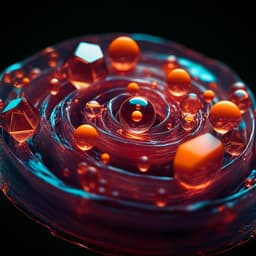
Physics
Ultrafast transient infrared spectroscopy for probing trapping states in hybrid perovskite films
A. M. El-zohry, B. Turedi, et al.
This research by Ahmed M. El-Zohry and colleagues explores the innovative use of mid-infrared transient absorption to investigate electron dynamics in perovskite materials. The study reveals significant differences in trapping processes between iodide and bromide-based films—insights that promise to enhance our understanding of these materials.
Playback language: English
Introduction
Hybrid perovskite materials are gaining significant attention due to their exceptional photophysical properties and high performance in applications like solar cells and light-emitting diodes. However, controlling the number of trap states, particularly in thin films, remains a challenge. Trap states, arising from structural defects or other sources, can reduce charge carrier mobility, thereby diminishing device performance and stability. While various techniques exist to identify and quantify trap states (electrical or optical measurements), limitations exist. For example, conductivity measurements have low time resolutions and cannot easily distinguish between electrons and holes, especially when their mobilities are similar. Common optical methods like time-resolved photoluminescence or transient absorption in the visible range lack direct spectral signatures for trapping states, instead providing kinetic rate variations between samples based on estimated trap density. A direct transient optical method for tracking and quantifying trapping processes and correlating them with charge dynamics is needed. This study addresses this need by using mid-infrared (mid-IR) probing to monitor the charge dynamics of four different perovskite films with varying compositions. Femtosecond transient absorption (fs-TA) in the mid-IR has been used for various systems, including metal complexes, organic dyes, metals, and semiconductors. In classical semiconductors, electron absorption in the conduction band produces a broad spectral signature. The positive mid-IR signal after photon excitation is attributed to free electron intra-transitions in the conduction band. Previous mid-IR studies on perovskites have focused on NH vibrational modes in organic cations. In contrast, this study's selected mid-IR region avoids such contributions, focusing solely on electron signals in the conduction band. This research proposes using fs-TA in the mid-IR as a sensitive tool to identify traps in hybrid perovskite films, investigating various films to study charge dynamics in the 4000–6000 nm (2500–1666 cm⁻¹) range. The results reveal that perovskite films with methylammonium (MA) cations and iodide (I) halides tend to exhibit mid-IR emission more than films with formamidinium (FA) and bromide (Br) derivatives, depending on conditions and film quality.
Literature Review
The introduction provides a comprehensive review of existing literature on the challenges of characterizing trap states in hybrid perovskites. It highlights the limitations of conductivity measurements and visible-range transient absorption techniques, emphasizing the need for a direct and sensitive method to probe trapping processes. The authors cite numerous studies on the use of mid-IR transient absorption in various systems, establishing the technique's potential for this application. They also refer to existing mid-IR studies on perovskites, differentiating their approach by focusing on the electron signatures in the conduction band rather than vibrational modes of organic components. This review effectively sets the stage for the current study by highlighting the gap in the existing literature and the rationale behind the chosen methodology.
Methodology
The study synthesized and used various hybrid perovskite films to investigate their charge dynamics in the mid-IR region (approximately 4000–6000 nm or 2500–1666 cm⁻¹). Femtosecond transient absorption (fs-TA) spectroscopy was employed. The process began with the preparation of the perovskite films on CaF₂ substrates. The substrates were cleaned using standard procedures (DI water, acetone, IPA), followed by UV ozone treatment. FAPbBr₃ and FAPbI₃ thin films were prepared using a modified antisolvent dripping technique. Specific concentrations of FAX and PbX₃ were dissolved in DMF:DMSO (9:1 ratio), spin-coated, and then toluene was drop-casted. Annealing followed at different temperatures depending on the specific perovskite. The fs-TA setup used excitation wavelengths ranging from 410 to 520 nm and probe light from 4000 to 6000 nm. The excitation power varied depending on the wavelength, ranging from approximately 100 to 300 µW. The mid-IR light was detected using a nitrogen-cooled CCD. The researchers systematically varied parameters like film composition (exploring different halide combinations, including MAPbBr₃, MAPbI₃, FAPbBr₃, FAPbI₃, and MAPbIₓBr₃₋ₓ), excitation wavelength, and probing wavelength to investigate their influence on the observed transient signals. This thorough methodology allowed for a detailed investigation of the correlation between material composition, excitation conditions, and the dynamics of charge trapping.
Key Findings
The fs-TA measurements in the mid-IR revealed distinct behaviors for different perovskite films. For MAPbBr₃, a positive signal initially appeared due to electron population in the conduction band, decaying exponentially within a few nanoseconds. However, negative features emerged at longer timescales. The kinetic traces at different wavelengths showed variations, indicating a wavelength dependence of the negative features. Comparison with visible-range fs-TA data confirmed the validity of using mid-IR to track charge dynamics but also highlighted differences in the dynamics. In MAPbI₃, the transient mid-IR signal exhibited a time-dependent change over minutes, with the positive signal converting to a negative signal faster with longer irradiation times. This process was reversible. The appearance of the negative signal was attributed to an emissive trapping process. The FAPbBr₃ film exhibited primarily a negative signal close to time zero, followed by a positive signal, attributed to exciton thermalization/dissociation. The FAPbI₃ film showed a similar exciton dissociation process but also a negative signal attributed to trapping. The study of MAPbIₓBr₃₋ₓ films showed that the appearance time of the negative signal was dependent on the iodide content, with higher iodide concentrations leading to faster appearance. The dependence of the appearance time of the negative signal on the mid-IR probe energy was also demonstrated, with higher energy probes causing faster appearance. Finally, the excitation energy dependence showed that higher excitation energies increased the probability of electron trapping in emissive centers. A mechanism was proposed where, upon excitation, electrons in the conduction band absorb the mid-IR probe, leading to a positive signal. Non-radiative decay to the ground state (non-emissive trapping) or mid-IR emission (emissive trapping) could occur, depending on the presence of emissive trap states. The study showed that MA⁺ or I⁻ or both increase the likelihood of emissive trap states. Continuous irradiation increased the rate of trapping. The probe energy influenced the ability to liberate trapped electrons, with higher energy probes more effectively decoupling the electrons.
Discussion
The findings directly address the research question by providing a new method to identify and quantify trapping processes in perovskite films. The use of mid-IR transient absorption allows for the direct observation of emissive trap states, which are not easily detected by visible-range techniques. The correlation between film composition, excitation conditions, and trapping dynamics provides valuable insights into the factors influencing the performance and stability of perovskite devices. The observed wavelength and excitation energy dependence of the negative signal support the proposed mechanism involving emissive trapping centers and the ability of different energy probes to liberate trapped electrons. The reversible nature of the trapping process in MAPbI₃ highlights the dynamic interplay between light irradiation and ion migration. The results demonstrate the importance of considering both emissive and non-emissive trapping pathways in perovskite materials. These findings have significant implications for improving the design and optimization of perovskite-based devices by allowing for a more detailed understanding and control of trap state formation.
Conclusion
This study successfully demonstrates the use of mid-IR transient absorption as a powerful tool to study trapping processes in hybrid perovskite films. It reveals the existence of emissive trap states, controllable through film composition, excitation energy, and probe wavelength. The research highlights the potential of iodide-based perovskites for mid-IR emission and provides valuable insights into the mechanisms governing charge trapping in these materials. Future research could explore the precise nature of the emissive trap states, their relationship to specific defects, and the development of strategies to control and minimize trap state formation.
Limitations
While the study provides valuable insights into trapping processes, some limitations exist. The mechanism proposed for emissive trap state formation remains a postulation, requiring further investigation to confirm the detailed structural and electronic characteristics of these states. The study primarily focuses on specific perovskite compositions, and further research is needed to determine the generality of the findings across a broader range of materials. Additionally, while the reversible nature of trapping is observed in MAPbI₃, a more in-depth analysis of the kinetics and the underlying processes would be beneficial.
Related Publications
Explore these studies to deepen your understanding of the subject.







